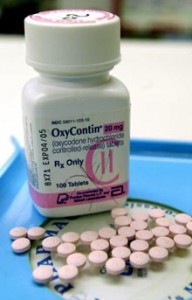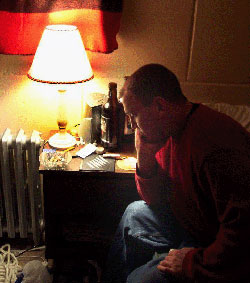
OxyContin Detox

Table of Contents
OxyContin is the brand name for a powerful pain medication whose primary ingredient is oxycodone, an opioid central nervous system depressant. Since the drug was first approved by the U.S. Food and Drug Administration (FDA) in 1995, OxyContin has become one of the most widely abused prescription medications in the United States. When taken under a doctor’s supervision, OxyContin is a clinically approved way to get extended relief for moderate to severe pain. But the FDA reports that the number of Americans over the age of 12 who use the medication for non-medical purposes is growing —over 500,000 people tried the drug for the first time in 2008 alone.
Once your body is dependent on OxyContin, getting the narcotic out of your system requires an intensive period of detox and withdrawal. If you stop using the medication suddenly or even cut down on the dose, you may suffer severe physical and psychological reactions that drive you right back to the drug.
The Power of OxyContin
 OxyContin addiction seems to be everywhere these days, affecting people of all ages from all socioeconomic groups. Although some people become dependent on the medication after receiving a legitimate prescription from their doctor, the drug is widely available on the streets, through online vendors and in medicine cabinets in many American homes. A study published in the American Journal of Psychiatry showed that many of the people who seek treatment for OxyContin abuse first obtained the drug from family members, friends, dealers, “pill mills” or other illegal sources rather than from a doctor.
OxyContin addiction seems to be everywhere these days, affecting people of all ages from all socioeconomic groups. Although some people become dependent on the medication after receiving a legitimate prescription from their doctor, the drug is widely available on the streets, through online vendors and in medicine cabinets in many American homes. A study published in the American Journal of Psychiatry showed that many of the people who seek treatment for OxyContin abuse first obtained the drug from family members, friends, dealers, “pill mills” or other illegal sources rather than from a doctor.
What makes OxyContin so addictive? Like morphine, codeine, heroin and other opiates, oxycodone is an opium derivative. If the drug is taken according to the manufacturer’s instructions and your doctor’s orders, it can minimize the severe discomfort caused by injury or illness. But when it’s taken recreationally, OxyContin produces an intense euphoria that’s similar to the effects of heroin. These sensations of well-being drive the user to return to the drug again and again, in spite of its potentially life-threatening side effects.
Opium derivatives affect the brain’s natural reward pathway, which evolved to provide positive reinforcement for healthy activities like eating and sexual reproduction. According to the Institute for Behavioral Genetics at the University of Colorado, the brain’s reward pathway lies in the limbic system, which is also responsible for functions like learning, memory and emotion. When you abuse opiates, your brain releases chemicals that trigger the reward pathways, reinforcing a behavior that’s potentially life-threatening rather than life-sustaining. Taking OxyContin on a regular basis can quickly lead to tolerance and dependence or addiction.
Health Risks of OxyContin Abuse
Whether you’ve been taking OxyContin every day, once a week, or every now and then at parties, you’ve undoubtedly noticed the pleasurable effects of the drug. If you suffer from pain caused by an injury, illness or disability, you may have come to rely on the drug to get you through the day as you go about your normal activities. If you’re going through a rough period in your relationship or you’re under a lot of stress at work, you might taken a few tablets to help you handle the emotional pain. But if you take your non-medical use too far, you may end up trapped in a cycle of addiction and withdrawal.
Oxycodone-based medications are classified as Schedule II controlled substances because of their high potential for abuse. Tolerance to OxyContin can develop rapidly, and in patients with severe chronic pain, it’s not uncommon to become physically dependent on the medication. In fact, dependence is considered to be of the greatest health risks of opiate pain medications.
According to Neuropsychology Review, abusing opiates for an extended period of time may have long-term neuropsychological effects, such as memory problems, difficulty concentrating and impaired motor skills. Opiate abuse can also interfere with circulation, respiration and natural immunity. Short-term side effects of these central nervous system depressants include:
- Difficulty breathing

- Slow heart rate
- Confusion
- Dizziness
- Tightness in your chest
- Wheezing
New users who take a single dose greater than 40 mg or who take more than 80 mg in a 24-hour period risk a fatal overdose, warns Drugs.com. The medication is especially dangerous when it’s combined with other central nervous system depressants, like alcohol. Because many people who take OxyContin recreationally combine the medication with other drugs, multi-drug overdoses are a serious risk.
OxyContin tablets are manufactured with a sustained-release coating that limits the immediate effects of the drug. One tablet may provide pain control for hours or for an entire day when the drug is taken as prescribed. Non-medical users often remove the sustained-release coating in order to get the full effects of the drug in a single rush. The powder can be snorted or injected for the maximum effect. The New England Journal of Medicine reports that a new form of OxyContin, approved by the FDA in 2010, minimizes the risk of abuse. The drug can’t be easily ground into a powder form or dissolved in liquid, making it difficult to inhale or inject intravenously.
How Do You Know if You Need Detox?
 OxyContin abuse has become so widespread that using the drug recreationally might seem commonplace. You may know more than one person who takes the drug regularly without suffering any obvious consequences. But it doesn’t take long before the casual user needs higher doses of oxycodone to get the same euphoric high. What starts as experimental use can develop into addiction once your brain’s natural reinforcement pathways have been affected.
OxyContin abuse has become so widespread that using the drug recreationally might seem commonplace. You may know more than one person who takes the drug regularly without suffering any obvious consequences. But it doesn’t take long before the casual user needs higher doses of oxycodone to get the same euphoric high. What starts as experimental use can develop into addiction once your brain’s natural reinforcement pathways have been affected.
Not everyone who uses OxyContin will become addicted. But a large number of recreational users do develop these signs and symptoms of addiction:
- Going to great lengths to obtain the drug, including forging prescriptions, stealing from friends or family, or selling the medication to others
- Feeling sick, confused or anxious when you can’t get your usual dose of the narcotic
- Using higher doses of OxyContin or switching from oral use to inhalation or injection in order to intensify the high
- Relapsing numerous times, even though you sincerely want to get the drug out of your system
Detox gives your body a much-needed break from the effects of opiates on your body and mind, creating the foundation for a healthier, more fulfilling life. At a supervised treatment facility, you can get medical help for the symptoms of drug withdrawal as you build the foundation for a healthier, more stable life.
Quitting at Home vs. Medically Supervised Detox
Quitting at Home
If you’ve decided that you’re ready to give up OxyContin, you might feel that quitting on your own is easier than going through detox. While there are advantages to quitting at home, such as avoiding the costs of medical detox, getting clean by yourself can be the wrong decision for several reasons:
- You don’t have the benefit of a full medical and psychological evaluation.
- You don’t have the opportunity to break away from the triggers and temptations of your daily life.
- You don’t have the support of counselors, doctors and other recovering addicts.
- You don’t have access to prescription medications that can help you overcome OxyContin addiction, like buprenorphine (Suboxone).
- You may never get to the root causes of your addiction or learn how to cope with the stresses of life without turning to drugs.
Medically Supervised Detox
With a home detox, you may get clean for a few days or a few weeks. You might stay off OxyContin and achieve a full recovery without any professional help. However, without the resources provided by a professional rehabilitation facility, the process will be much more difficult on a physical and psychological level. Medical detox can help you get through the worst symptoms of opiate withdrawal, such as:
- Severe cravings for oxycodone
- Restlessness, agitation and anxiety
- Depression, confusion and disorientation
- Nausea and vomiting
- Cold sweats and tremors
- Muscle pain and cramps
- Sleeplessness
- Nasal congestion
- Itching
- Rapid heart rate
Withdrawing from OxyContin may make you feel like you have the flu. You may feel weak, tired, achy and sick to your stomach. But the worst part of getting through detox without any help is the lack of psychological support. Instead of turning to a therapist, attending support groups or taking medications to relieve your symptoms, you may have very few reliable resources if you detox by yourself.
At Axis, we can help you through OxyContin withdrawal with a detox program that’s uniquely tailored to your needs. Our detox program leads naturally into the rehabilitation phase of your recovery, where you’ll learn how to create a future that’s satisfying, rewarding and drug-free. We believe that the more tools you have at your disposal, the greater your chances of long-term success. Contact our treatment team to discuss our individualized approach to opiate recovery.






